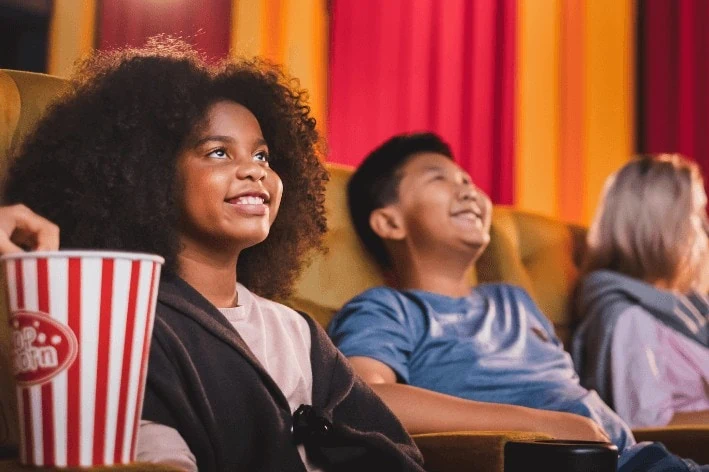Table of Contents
Have you ever seen “sensory-friendly movie” advertised and wondered what it meant? You’re not alone! This blog unravels the mystery and explores the benefits for both moviegoers and theaters.
What are Sensory-Friendly Movies?
Sensory-friendly movies offer a modified experience to accommodate those with sensory sensitivities. For instance, while the film itself remains unchanged, adjustments are made to the environment:
- Lights: Theaters typically keep the house lights on or dimmed, reducing the stark contrast to the bright screen.
- Sound: The volume is lowered to create a less overwhelming soundscape.

Who Benefits from Sensory-Friendly Movies?
To illustrate, sensory-friendly screenings cater to a wide audience:
- Children: With more wiggle room and potentially increased noise from a younger crowd, sensory-friendly movies provide a more relaxed environment for families.
- Adults with Sensory Sensitivities: Individuals with autism, ADHD, PTSD, or even hearing loss can benefit from the adjusted audio and visual elements.
- Anyone Seeking a Calmer Experience: Sometimes, even without sensory sensitivities, a quieter, less intense movie experience can be enjoyable.
Important Considerations:
- Expect a Different Vibe: Sensory-friendly screenings often attract families with young children. As a result, be prepared for a more relaxed atmosphere with potentially more movement and noise.
- Not All Sensory-Friendly Experiences Are Identical: Each theater may offer slightly different modifications.
Accessibility Features:
Movie theaters are increasingly becoming more inclusive by offering additional accessibility features:
- Reserved Seating: Designated wheelchair-accessible seating ensures a comfortable and convenient experience.
- Companion Seats: These seats are reserved for people attending a movie with someone who has a disability.
- Assistive Listening Devices: Headsets or assistive listening glasses project closed captions or amplify sound for those who are hard of hearing.
Beyond the Screen: Audio Description and Closed Captioning
For those with visual or hearing impairments, some theaters offer:
- Audio Description (AD): A narrator describes visual elements of the movie through a headset, making the film more accessible for blind or visually impaired viewers.
- Closed Captioning: Text captions displayed on the screen provide dialogue and sound effects for viewers who are deaf or hard of hearing.

Exploring the Sensory-Friendly Movie Landscape:
Many theater chains offer sensory-friendly screenings, though availability and specifics may vary. Here are few examples:
The Many Names of Sensory-Friendly Movies:
In addition, there’s a wide range of terms used to describe sensory-friendly movies. Here are a few:
- Autism-friendly movies
- Relaxed screenings
- Sensory-sensitive movies
It’s important to note that “sensory-friendly” and “relaxed performances” are not always interchangeable. In contrast, relaxed performances, for example, typically refer to live shows, not movies.

Sensory-Friendly vs. Autism-Friendly: Understanding the Distinctions
While the terms “sensory-friendly” and “autism-friendly” are often used interchangeably, importantly, there are some subtle distinctions between the two. So, let’s delve deeper and explore these differences:
- Target Audience: Sensory-friendly screenings aim to create a welcoming environment for a broader audience. Thus including individuals with autism, ADHD, sensory processing disorders, PTSD, or those who simply prefer a calmer atmosphere. Autism-friendly screenings, however, are specifically designed to cater to the needs of people on the autism spectrum.
- Level of Customization: Autism-friendly screenings might involve a more tailored approach. For instance, with additional staff training on understanding and responding to autistic behaviors. On the other hand, sensory-friendly screenings may not involve the same level of autism-specific customization.
- Focus: Sensory-friendly screenings prioritize adjustments to the sensory experience (lights, sound, etc.). Alternatively, autism-friendly screenings might incorporate these adjustments alongside additional considerations like social interaction or predictable routines.
In essence, sensory-friendly screenings are the broader umbrella, encompassing autism-friendly screenings. In contrast, autism-friendly screenings are a specific subset designed to address the unique needs of the autistic community.
Sensory-Friendly Movies: Making Moviegoing Inclusive
Sensory-friendly movies are a fantastic way to make the moviegoing experience more enjoyable for everyone, especially those who may find the traditional theater environment overwhelming. Furthermore, by offering a more relaxed environment and accessibility features, theaters can create a welcoming space for a wider audience.
Expanding the Reel: Inclusion Practices Beyond Sensory-Friendly Screenings
Sensory-friendly movies are a fantastic step towards inclusivity! However, movie theaters can go beyond dimmed lights and lowered volume to create a truly welcoming space for everyone. For example, here are some additional practices theaters can implement:
- Visual Storytelling: Offering movies with closed captioning and audio description is essential for viewers who are deaf, hard of hearing, blind, or visually impaired. Importantly, these features allow everyone to enjoy the full cinematic experience.
- Accessible Seating: Ample designated wheelchair-accessible seating with good sightlines ensures a comfortable and convenient experience for patrons with mobility challenges.
- Assistive Listening Devices: Providing a variety of assistive listening devices, like headsets or glasses that project closed captions or amplify sound, caters to patrons with hearing loss.
- Service Animals: Movie theaters should welcome trained service animals to accompany patrons who require their assistance.
- Relaxed Restrooms: Offering larger, accessible restrooms with adult-sized changing tables can be a game-changer for families with young children or patrons with disabilities.
- Clear Signage: Using clear, concise signage with contrasting colors and large fonts makes navigating the theater easier for everyone. Specificaly, including those with visual impairments or cognitive differences.
- Accessible Website and Ticketing: Websites and ticketing systems should be fully accessible, with features like screen reader compatibility and keyboard navigation.
- Staff Training: Training staff on disability etiquette, including how to interact with patrons who may need assistance or have specific communication styles, fosters a more welcoming environment.
In summary, by implementing these practices, movie theaters can create a space that is truly inclusive and allows everyone to enjoy the magic of cinema.
Dive Deeper into Sensory Experiences: A Documentary Recommendation
Intrigued by the world of sensory-friendly movies? Moreover, do you want to see how sensory overload feels from a firsthand perspective? Then, look no further than the powerful short documentary, “Too Busy. Too Noisy. Too Bright.” by Sensory Friendly Solutions.
This eye-opening short film takes you on a journey through the eyes (and ears!) of someone experiencing sensory overload. For instance, you’ll also hear inspiring stories from youth and communities who have embraced sensory-friendly initiatives. In conclusion, it’s a must-watch for anyone who wants to understand the impact of sensory processing and the importance of creating inclusive spaces for everyone.
So, grab some popcorn, settle in, and get ready to be enlightened by the world of sensory experiences!
Keep Exploring the Sensory-Friendly World!
Sensory-friendly experiences are blossoming in the arts and culture scene! Moreover, this blog post has just scratched the surface. Intrigued by how museums, art galleries, or even live performances are becoming more inclusive? Then read on:
- An Art Museum Hosts a Virtual Sensory-Friendly Workshop
- Unveiling a World of Art for All
- Create a Sensory-Friendly Zoo Experience
Christel Seeberger has worked in health care for 30 years, including helping people with sensory sensitivity who experience sensory overload. Christel has a hearing disability and experiences sensory sensitivity and sensory overload herself. She founded Sensory Friendly Solutions in 2016 to make the world more sensory-friendly, accessible and inclusive.



